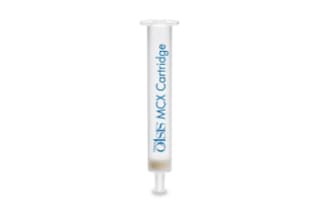
|
UNSPSC |
41115712 |
|
Brand |
Oasis |
|
Product Type |
Solid Phase Extraction |
|
Units per Package |
100 pk |
|
Chemistry |
MCX |
|
Endcapped |
No |
|
Format |
Vac Cartridge |
|
Ion Exchange Capacity |
1 meq/gram |
|
Mass Spec Compatibility |
Yes |
|
Mode |
Mixed mode |
|
Particle Size |
60 µm |
|
Pore Size |
80 Å |
|
Sorbent Substrate |
Copolymer |
|
Sorbent Weight |
60 mg |
|
Water Wettable |
Yes |
|
pH Range Min |
0 pH |
|
pH Range Max |
14 pH |
|
Material |
Polypropylene |
|
Barrel Size |
3 cc |

Oasis MCX 3 cc Vac Cartridge, 60 mg Sorbent per Cartridge, 60 µm, 100/pk
With a tightly controlled ion-exchange capacity, the Oasis MCX (mixed-mode cation exchange) sorbent enables you to obtain selective retention of basic drugs with cation-exchange groups on the sorbent surface. The sorbent doesn’t contain any silanol groups to complicate the retention mode or method development, which is simple and fast due to the water-wettable, polymeric nature that is stable from pH 0-14. Because the ion-exchange sorbent is synthesized from the reversed-phase Oasis HLB copolymer, it uses two retention mechanisms (both cation exchange and reversed-phase), which can be predictably manipulated. Like all Oasis family lab equipment, the MCX sorbent is designed to improve and simplify sample preparation.
Along with the pH stability typical of DVB polymers, Oasis MCX offers a greater binding capacity than silica-based mixed-mode SPE sorbents and offers the ability to fully manipulate pH [0-14] during development, optimization, and use of SPE methods. This enables fast, straightforward method development as well as rugged and robust procedures with no analyte breakthrough or loss of recovery as a result of dissolving silica particles at high pH, or cleave bonded phase at low pH. The water-wettable nature of the sorbent allows it to maintain the capability for higher retention and superior recoveries, even when the sorbent runs dry.
The Oasis MCX is packaged here in a syringe-barrel cartridge, designed for use with vacuum manifolds and automated SPE instruments, with each cartridge containing 60 mg of sorbent. Using Waters’ well-controlled and novel production process, Oasis MCX is reproducibly delivered with 1.0 meq/g of sulfonic-acid-ion-exchange capacity. Oasis MCX 3 cc Vac cartridge is available in a 30 µm particle size as well and works well in conjunction with the XSelect HSS T3 XP Column, 100Å, 2.5 µm, 2.1 mm X 100 mm, 1/pk.
What Is Mixed-Mode Chromatography?
Mixed-mode chromatography, also known as multimodal chromatography, is a chromatographic method that utilizes more than one form of interaction between the stationary phase and analytes to achieve separations. This is different from traditional single-mode chromatography because the secondary interactions in mixed-mode cannot be too weak, and they contribute to the retention of the solutes. Chromatographers may choose this method as it offers higher selectivity and higher loading capacity. One mixed-mode column can replace two or more single-mode columns, making it an economically sound and eco-friendly decision for employing the stationary phase, while reducing the consumption and waste of raw materials.